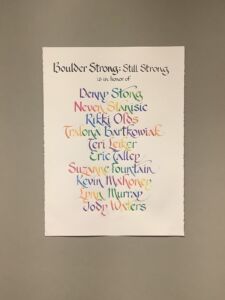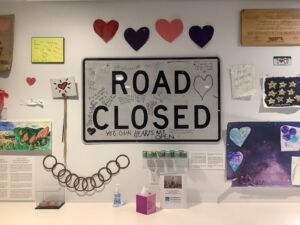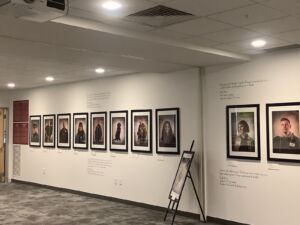‘Boulder Strong’: The physical remembrance of a community uniting
After the March 2021 shooting that rocked the Boulder community, people from around the city and state came to express sorrow, hope and strength for the future. Now those artifacts are on display at the Museum of Boulder through April 10.
For decades, the King Soopers on Table Mesa Drive was a hub for the South Boulder community—not only a grocery store, but a place for mingling with friends and catching up with neighbors.
On March 22, 2021, that sense of familiarity was disrupted. Where two red-peaked entranceways once led to food and comfort, trauma and unease took residence following a shooting that took the lives of 10 Boulder community members.

In the days and weeks following the shooting, community members visited the fenced-off site to pay respects. For some, that involved standing in silence, and for others, that meant laying flowers and displaying art pieces to commemorate the lives lost and to ensure Boulder’s endurance.
Handmade crosses lined the chain link fence, along with thousands of memories and wishes for no other communities to experience such a tragedy. From around Colorado, people turned out to pay their respects and offer peace, hope and strength.
As reconstruction took place on the since reopened grocery store, those artifacts left at the fenceline have now found a new home in the Museum of Boulder’s collections. Among those artifacts include several dozen now on temporary display at the museum, in an exhibit devoted to remembering not only the day of tragedy but also the resilience of South Boulder.
Following the shooting, museums around the country in cities that have experienced similar tragedies reached out with words of support and advice on how best to preserve mementos from these violent episodes. That input, along with the perspectives of Boulder community members, led to the creation of this exhibit.
Chelsea Pennington Hahn, Curator of Collections at the museum, described the extensive process of putting the exhibit together. Rather than focusing on the tragedy and violence itself, “we tried to choose artifacts that capture the heart of that response,” Pennington Hahn said. “We wanted to create a reflective, healing space.”
One item, a “Road Closed” sign, was of particular interest to Pennington Hahn, who described it as an everyday item that became an outlet for expression. “[The sign] is an organic display of people wanting to convey feelings,” she said.

Other objects include receipts from those inside the store that day, as well as pleas to lawmakers to enact preventative change. “Enough Is Enough,” reads one rain-marked poster. “The Only Guns That Should Be Legal Are Nerf,” reads another.
Love and strength also appear throughout the exhibit. “#BoulderStrength” says a small red paper heart. “I am thinking about you. I am so sorry for your loss,” says a yellow sheet signed by an 8-year-old community member.
In a state marred with mass shootings, from the 1999 Columbine High School massacre to the 2012 Aurora movie theater shooting, this exhibit is a reminder of strength and community healing in those events. The slogan “South Boulder Strong” echoes across the signage.
In the space, over two dozen portraits of Boulder residents line the walls, each with a connection to the tragedy. The portraits, a collaborative effort between CU Boulder photojournalist and professor Ross Taylor and the museum, instill the range of experiences of those connected to the Table Mesa store. Portraits include first responders, service dogs, store employees, survivors and neighbors who witnessed events unfold.
“Through this collective archive, we’re showing our strength as a community. It’s a step forward in a reclamation of sorts,” writes Taylor in one of the exhibit’s write-ups.

No artifacts are from the store itself—the collection consists solely of objects placed by community members on the fenceline.
While the display is only up temporarily, through April 10, the museum is working to digitize all objects. Family members of the victims have access to the museum’s collections related to the event—an open-ended invitation to observe objects and process as needed.
Future displays of these objects are still under consideration, with Pennington Hahn describing those decisions as evolving with community needs. “We want to be flexible and transparent,” she said. “We want to be gentle with the community.”
For anyone seeking support from the shooting, the Boulder Strong Resource Center remains open and ready with resources.
The Museum of Boulder can be found at 2205 Broadway, near downtown Boulder.

